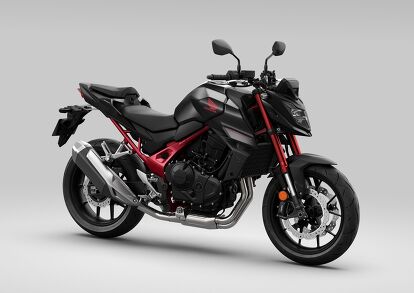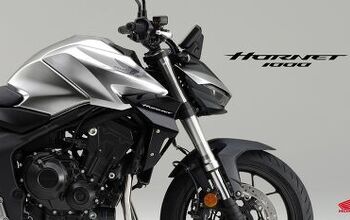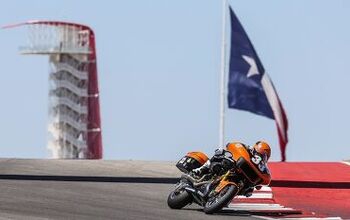2023 Honda CB750 Hornet - First Look

No word on US availability
Honda officially revealed its new CB750 Hornet, a new middleweight naked claiming a class-leading power-to-weight ratio. Unfortunately, the new Hornet has only been confirmed for Europe thus far, with no indication of U.S. availability. Pricing varies from country to country, but they generally hover around US$7,800.
The CB750 was designed by Honda’s R&D team in Rome, drawing elements from past Hornet models. The fuel tank design was inspired by the shape of a hornet’s wing. Initial concepts and sketches leaned more towards KTM Duke-styled edges, but the effect looks subdued in the finished product.
As previously revealed, the new Hornet is powered by a 755cc Parallel-Twin engine with a 270° crank and a Unicam head. Honda claims a peak output of 90.5 hp at 9,500 rpm, which is about as much power as the CB650R’s Inline-Four. The CB750 Hornet, however, comes in about 26 pounds lighter than the 650, with a claimed wet weight of 419 pounds. Peak torque is a claimed 55.3 lb-ft. at 7,250 rpm.
The engine is matched with an assist and slipper clutch and a six-speed manual transmission. The CB750’s Throttle-by-Wire system offers three ride modes (plus a user custom mode), a three-level traction control system, wheelie control and engine braking control. To help reduce weight, the primary drive also serves as a balance shaft.
The chassis is comprised of an all-new steel diamond frame designed to provide optimal stiffness while also contributing to the Hornet’s relatively light weight. The front wheel is suspended by a 41mm Showa SFF-BP inverted fork offering 5.1 inches of travel. The rear wheel is attached to a Pro-Link swingarm with a preload-adjustable monoshock providing 5.9 inches of travel.
The front wheel is equipped with dual 296mm discs and Nissin radial-mount four-piston calipers. A single-piston caliper and 240mm rotor handles rear wheel braking duties.
A two-channel ABS comes standard, as does an Emergency Stop Signal (ESS) function. When traveling at speeds above 35 mph, ESS flashes the rear lights warning other road users of a hard stop when it detects the brakes applying negative acceleration above a certain threshold.
A 5″ TFT full color display offers a choice of four types of speedometer and tachometer displays, as well as a fuel gauge, gear indicator and other data related to the electronics. The Hornet is also equipped with the Honda Smartphone Voice Control system to allow voice management of phone calls, messages, music and navigation. The system works with helmet-mounted headsets and connects via Bluetooth with both Android and iOS phones.
Other features include a USB type-C port, a 31.3-inch seat height, and self-canceling turn signals. Honda also offers a number of accessories that can be purchased a la carte, or in three packages. The Sport Pack includes a quickshifter, fly screen, rear seat cover and upgraded footpegs. The Style Pack combines bar end weights, a handlebar upper clamp holder, tank pad, wheel stripes and crash protectors. The Touring Pack adds panniers, a tank bag and a seat bag.
The 2023 Honda CB750 Hornet will come in four color options. The Pearl Glare White and Graphite Black options come with a Metallic Red Flame frame and matching anodized red fork. The Matte Iridium Gray Metallic and Mat Goldfinch Yellow options come with a black frame and chrome fork tubes.
2023 Honda CB750 Hornet Specifications | |
|---|---|
| Engine Type | Liquid-cooled OHC 4-stroke 8-valve Parallel-Twin with 270° crank and uni-cam |
| Displacement | 755cc |
| Bore x Stroke | 87mm x 63.5mm |
| Compression Ratio | 11.0:1 |
| Max. Power Output | 90.5 hp at 9,500 rpm (claimed) |
| Max. Torque | 55.3 lb-ft. at 7,250 rpm (claimed) |
| Max Speed | 127 mph (claimed) |
| Oil Capacity | 3.8L |
| Starter | Electric |
| Carburation | PGM-FI electronic injection |
| Fuel Tank Capacity | 4.0 gallons |
| Fuel Consumption | 54 mpg (claimed) |
| Battery Capacity | 12v 7.4Ah |
| Clutch Type | Wet multiple, Assisted slipper clutch |
| Transmission Type | 6 speed Manual Transmission |
| Final Drive | Chain |
| Frame Type | Steel diamond |
| Front Suspension | Showa 41mm SFF-BPTMTM USD, 5.1 inches of travel |
| Rear Suspension | Monoshock damper, Pro-Link swingarm, 5.9 inches of travel |
| Front Wheel | 5Y-Spoke Cast Aluminum |
| Rear Wheel | 5Y-Spoke Cast Aluminum |
| Front Tire | 120/70ZR-17 |
| Rear Tire | 160/60ZR-17 |
| ABS Type | 2 channel |
| Front Brakes | Dual 296mm x 4mm disc with Nissin radial mount 4 piston calipers |
| Rear Brakes | Single 240mm x 5mm disc with single piston caliper |
| Instruments | TFT screen |
| Headlight | LED |
| Taillight | LED |
| Connectivity | HSVC |
| USB | Type C |
| Self-cancel Signals | Yes |
| Security System | HISS |
| Additional Features | ESS, 4 Riding Modes |
| Length | 82.3 inches |
| Width | 30.7 inches |
| Height | 42.7 inches |
| Wheelbase | 55.9 inches |
| Rake | 25˚ |
| Trail | 3.9 inches |
| Seat Height | 31.3 inches |
| Ground Clearance | 5.5 inches |
| Kerb Weight | 419 pounds |
| Turning radius | 8.9 feet |
Become a Motorcycle.com insider. Get the latest motorcycle news first by subscribing to our newsletter here.

Dennis has been a part of the Motorcycle.com team since 2008, and through his tenure, has developed a firm grasp of industry trends, and a solid sense of what's to come. A bloodhound when it comes to tracking information on new motorcycles, if there's a new model on the horizon, you'll probably hear about it from him first.
More by Dennis Chung




















































































































































































Comments
Join the conversation
Bring this to the US, and I'll reserve one immediately!! I think this is perfect for me; restarting in the hobby after some decades, wanting a good, solid, well-put-together bike with the Honda name behind it, with more horses than I need and a good weight.. and the introductory price in Europe is exciting, to say the least. Yes, the looks are somewhat pedestrian but I don't care; so Honda, bring it to the US!!
New Honda CB750 Hornet vs its primary competitor--- Suzuki GSX-8S
The Honda CB750 Hornet is a better bike than the Suzuki GSX-8S --- Better looking front-end, more powerful (+ 9 hp), better handling, much lighter (26 lbs. less), less expensive ($1,000), better for shorter riders (.6" lower seat), larger fuel tank (+ .3 gallons), basic color options, SOHC as opposed to DOHC (see why below), and better reliability (Suzuki is very reliable, but Honda is at top of Big Four).
Benefits of SOHC instead of DOHC (per Honda):
"a single overhead cam, which Honda says gives several advantages over a twin cam: the cylinder head can be lighter and more compact, there’s space for the valves and intake to be more upright and with fewer parts spinning around creating inertia, the handling is improved, too."